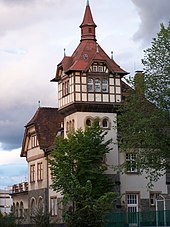Niederrad sewage treatment plant
The former Niederrad sewage treatment plant served as a sewage treatment plant for the city of Frankfurt am Main from 1887 to 1960 . Together with the former sewage treatment plant in Krefeld, it is one of the last two remaining sewage treatment plants from the founding time of city drainage in Germany.
history
In 1867 the city of Frankfurt am Main began building a modern alluvial sewer system . Soon after the sewer system was put into operation, residents down the Main came to complain about the unreasonable pollution of the river from the urban sewage. There was no space for the discharge in Rieselfelder , which was customary at the time , so the city decided to build a mechanical sewage treatment plant on the Niederräder Ufer based on the English model. The facility, approved on October 31, 1882 and built from 1883 to 1887 under the direction of William Heerlein Lindley , was the first of its kind in Germany.
From 1902 to 1904, the facility, designed for 140,000 residents, was expanded to 300,000 population equivalents and mechanized in order to improve working conditions in the facility. The sewage treatment plant was in operation in this form until 1960 and then served as a system for treating rainwater until 1990. The complex is under monument protection and was renovated in 1992/93 in accordance with monument protection . It is part of the Route of Industrial Culture Rhein-Main . The environmental laboratory of the City of Frankfurt am Main is now located in the old company building.
Cleaning process
The Niederrad sewage treatment plant was built as a sunk , covered and vaulted system with a sand trap , rake , mixing chamber and the underground sewage chambers with inlet and outlet gallery . It was designed for 140,000 residents and could treat 18,000 cubic meters of wastewater every day. In the first cleaning stage, the sand trap, heavy mineral components of the wastewater settle on the ground. The subsequent rake removed the coarse impurities until the wastewater only contained fine suspended matter . In the subsequent mixing chamber, the water was mixed with sulphate of clay and lime before it reached the four underground sedimentation basins, each 82 meters long. Due to the slow flow rate and the chemical reaction, the suspended matter gradually fell out until the treated wastewater was channeled into the Main via the wastewater gallery.
The settling basins were cleaned manually by workers under what are now unreasonable working conditions. The system had to be completely shut down for manual cleaning. The sewage sludge was initially used as fertilizer in agriculture, later dried and burned together with household waste in the neighboring waste incineration plant. After the incineration plant was shut down around 1920, the sewage sludge was mostly dumped or used as filler material in agriculture.
As part of the expansion from 1902 to 1904, the system was expanded to include three more settling basins. The ineffective chemical cleaning stage was shut down because it also polluted the Main with COD . All the basins were divided in the middle and the inlet gallery was moved there, as operational tests had shown that sufficient sedimentation took place even with a pool length of 42 meters . At the same time as the expansion to 14 settling basins, the sand trap received an excavator and the rake system was mechanized. A sludge extraction system was installed to improve the cleaning of the settling basins. In particular, this improved the working conditions and the availability and cleaning performance of the system. A total of 45,000 cubic meters of wastewater could now be cleaned every day.
literature
- Volker Rödel: Civil engineering in Frankfurt am Main 1806–1914 . Contributions to urban development. Societäts-Verlag, Frankfurt am Main 1983, ISBN 3-7973-0410-2 , p. 63-67 .
- Into the Main. (PDF) Wastewater discharge, wastewater treatment and bodies of water in Frankfurt am Main. SEF Stadtentwässerung Frankfurt am Main, accessed on February 20, 2019 .
Web links
- State Office for Monument Preservation Hessen (Hrsg.): Niederrad sewage treatment plant In: DenkXweb, online edition of cultural monuments in Hessen
- State Office for Monument Preservation Hessen (Ed.): Niederräder Klärwerk-Gasmaschinenhaus In: DenkXweb, online edition of cultural monuments in Hessen
- Website of Stadtentwässerung Frankfurt am Main
Coordinates: 50 ° 5 ′ 15.3 " N , 8 ° 37 ′ 37.3" E

